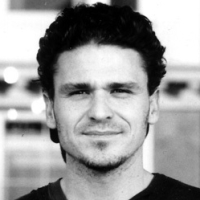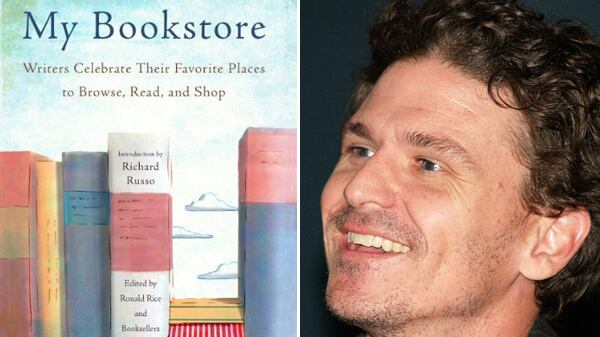I feel weird choosing just one Bay Area bookstore, because at different times in my 20 years living out here, I’ve frequented Black Oak and Pegasus Books and Cody’s and Moe’s in Berkeley, Book Passage and the Depot in Marin County, Books Inc. and Modern Times and Dog Eared and City Lights in San Francisco, and many others in between. The Bay Area has the most independent bookstores in the country—maybe the world—but for the purposes of this collection I’d like to mention the first store I had a relationship with in San Francisco, Green Apple Books. They’re also the ones who mentioned this book about indies, the one in which you’re reading this essay, so they get dibs.

My brother Toph and I lived in the Laurel Village/Richmond area for a few years, and when we did, the bookstore we went to was Green Apple. Like a lot of great bookstores, on the outside, Green Apple is deceptively simple, humble, even misleading. At first glance, you’d think it was actually a fruit market. There’s the store’s name, of course. Then there’s the green awning, the global symbol for produce. There are even a few bins outside, where fruit would normally go. The first of many times I passed by, driving or walking on the other side of the street, I thought, huh, another fruit market, and moved on. But it’s a bookstore, and it’s a world-class bookstore, and people love it deeply, and I love it deeply.
It was started by a former soldier named Richard Savoy, who in 1967 borrowed a few hundred dollars from a credit union to rent a storefront on Clement Street in San Francisco’s Richmond District—a wonderfully diverse, predominantly Chinese and Russian neighborhood also known as the Avenues. The store originally carried used paperbacks and comics and magazines, but it was successful from the start and grew steadily over the years, into new books, and collectors’ books, and every genre available, while always expanding physically, too. Into the second floor, and over into some of the neighboring storefronts; it’s gone from 700 square feet to 8,500. Not bad for an independently owned store opened by a guy with no experience in the business.
ADVERTISEMENT
Mr. Savoy ran the store for 42 years, until 2009, when he handed the reins over to three longtime staff members—Kevin Hunsanger, Kevin Ryan, and Pete Mulvihill—who own the store and run it together. I’ve known these guys for about 15 years now, and I have to say there are no purer book people in the world. They know their store, they know their customers, and of course they know books. They know everything Green Apple carries, which is more or less everything—new books, used books, antiquarian rarities, humor oddities, coffee-table masterpieces, paperback thrillers. The crazy thing about Green Apple is that everything, even a cat calendar, seems far more interesting and wantable in their hands.
This is the beauty of atmosphere and careful, inspired curation. First, a few words about atmosphere. Green Apple’s floors, most of which are over a hundred years old, creak wherever you go, and when you walk upstairs, there will be small clouds of dust. The place is old, and smells old, in the best sense; it smells like paperbacks and sun and paperbacks faded in the sun. It smells of 1904, when the building was erected, and it smells of every decade and era in between. It smells of ink and leather shoes. The shelves occasionally bend in the middle. The hallways are narrow and the upstairs rooms are often small. It is a warren. It is a labyrinth. It has the feeling of the Winchester Mystery House, a building that seems to go on forever and into impossible directions and illogical spaces. But it never feels cramped. Instead, there is the feeling you get when walking into a house of worship with 50-foot ceilings and stories told in stained glass, a feeling of grandeur and possibility.
There have been marriage proposals proffered in the store. Former employees have married each other. People, or at least one person, has died in the store (he had a heart attack, and, for the first time anyone could remember, just afterward, a bird flew in, alighted briefly, and left through the window). The store is frequented by children, by tourists, by older women seeking Patricia Highsmith, by students, by sellers of used books (the store has six full-time buyers), by passionate young readers, by last-minute holiday shoppers, and by Robin Williams.
I may need to check the data on this one, but my informal research says that no one has ever left the store empty-handed. I have personally never left the store without buying something.
There is a lesson here. I think stores should be well organized and have self-contained sections where you can find your philosophy books, your nonfiction, your books about fast cars, on and on. But there is equal, and possibly greater, benefit, in having these sections closely intermingling, or even overlapping. When you walk into Green Apple, the new and best-selling books are right there, in your face, but just to the left are the oversized art books, and there’s always something that jumps out at you there, or just a few inches from those, where they keep 50 or so different new paperbacks, carefully curated, reminding you of all the books you missed in hardcover but would be a fool to miss now. Within a few feet are the humor books, the topical ones about zombies and shark-fighting. And again, in Green Apple, everything seems essential. Even without their thousands of handwritten notes of recommendation—which of course are heartfelt and urge-creating—even without these, something in the building casts a light of wonder and inevitability on everything they carry. Maybe it’s the history of the building, which predates and survived the earthquakes of 1906 and 1989 and has the psychic wounds to show for it. Maybe it’s the history of the business, which is after all the history of small family businesses in America. Maybe it’s just the feeling that if a bookshop is as unorthodox and strange as books are, as writers are, as language is, it will all seem right and good and you will buy things there. And if you do, it will persist, and small publishers will persist, and actual books will persist. Anyone who wants anything less is a fool.
Excerpted and adapted from My Bookstore: Writers Celebrate Their Favorite Places to Browse, Read, and Shop edited by Ronald Rice. Copyright © 2012 by Dave Eggers. Used by permission of Black Dog & Leventhal Publishers. All rights reserved






